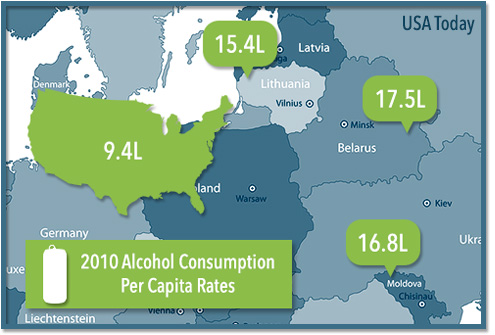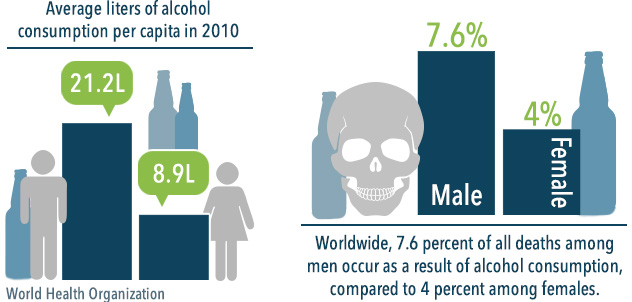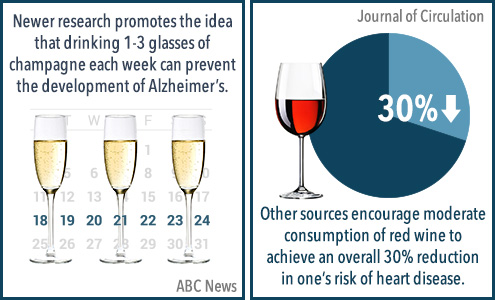Overview of Alcohol Consumption throughout the World
Alcohol has been a staple in social circles for centuries, and this is true all over the world. From weddings and birthdays to graduations and coming-of-age ceremonies, alcohol is often a part of cultural celebrations in just about every country. Just as alcohol consumption is prevalent all over the world, alcohol abuse issues also exist worldwide.

Alcohol Consumption Rates
Alcohol consumption is relatively high in the United States. Past-month rates of alcohol use in 2013 among American adults reached 56.4 percent.[1] Modern-day American society promotes the idea of a daily cocktail, or two or three, as being acceptable and even good for you. Advertisements promote the concept of moms who need wine and the idyllic image of dad drinking a few beers after a long day at work. Despite these happy images, parental alcohol abuse often perpetuates a cycle of addiction. Children raised by parents who battle alcoholism are 2-4 times more likely to struggle with addiction themselves.[2]

Alcohol is viewed differently in different areas of the world. Despite its many pleasant associations, public views of alcohol in the United States, Australia, the United Kingdom, and some other areas acknowledge that it is sometimes known to influence violent and antisocial behaviors. Alcohol and other drugs are contributing factors to over half of all violent crimes.[3] However, in other nations this association may not be as acknowledged. In South American and Mediterranean cultures, alcohol consumption is viewed as somewhat of a rite of passage that promotes peacefulness and relaxation.[4]
Eastern European nations tend to drink more alcohol than most nations. Alcohol consumption is highest in Belarus where annual per capita rates reached 17.5 liters in 2010.[5] Hungary and Russia also consume a large amount of alcohol. All three of these nations have some of the highest rates of alcoholism in the world.[6] Next in line to Belarus is the Republic of Moldova at 16.8 liters and Lithuania at 15.4 liters.[7] Americans actually consume less alcohol than any other developed nation at just 9.4 liters on average per year per capita.[8]
Interestingly, only around half of the global population accounts for all alcohol consumed. Approximately half of the world’s population hasn’t ever consumed alcohol, largely due to various nations with very low alcohol consumption rates, such as predominantly Muslim countries.[9] While certain regions – namely those known for producing the beverage – are heavy wine consumers, more people are drinking beer and liquor than anything else. Around 45 percent of all alcohol consumed around the world is liquor.[10]
When Consumption Equals Abuse
In many cases, alcohol consumption is severe enough to be termed alcohol abuse. Contrary to popular belief, the nations that report the highest rates of alcohol consumption are not the same places in which the highest rates of alcoholism and alcohol abuse exist. The two are not directly correlated; however, it is possible that the rate of alcoholism is somewhat underreported in nations where alcohol is consumed in higher amounts.
Alcoholism is likely underreported overall in any region where high amounts of consumption aren’t frowned upon. Many people don’t view increased drinking behaviors as poor or problematic if they aren’t producing ill effects. In sum, cultural norms may have a large influence over whether or not alcoholism is identified in a given population.
Of course, not every person who abuses alcohol is going to end up addicted to it. Binge drinking and late nights spent partying with friends are considered the norm in much of the developed world. Many who engage in these behaviors outgrow them over time. While 29 percent of the American population fits the criteria to be classified as heavy drinkers, only 10 percent could be diagnosed with alcoholism.[11] In 2013, past-month binge drinking was a problem for 24.6 percent of adults in the United States.[12] Across the pond in Ireland – holding the 11th rank among the world’s drunkest nations – binge drinking rates for individuals aged 15 and older were significantly higher at 39 percent.[13], [14]

Some people may not be addicted to alcohol, but they still have a drinking problem. Individuals who feel regretful or guilty about how much or how often they drink may fit this profile. In addition, those who hide the details about their drinking habits, those who experience blackouts, and those who regularly drink large amounts might have a problem. If friends and family members are routinely complaining about a loved one’s drinking habits or expressing concern about them, it might mean there’s a problem looming. The most glaring sign of a drinking problem is often found in those who feel they can’t relax without a cocktail or two. Unfortunately, this is common in today’s world.
Demographic Differences
Certain groups of people are more vulnerable to addiction. These include:
- Individuals of a certain age or gender
- Those affected by mental health disorders
- The unemployed and people who work in high-risk fields
- Wealthier populations
With regard to alcohol-related deaths, the 20-39 age demographic bears the highest burden, with a full quarter of all deaths in that age group being attributed to alcohol.[15] Gender also has a great impact on alcohol consumption and the effects of such. Worldwide, 7.6 percent of all deaths among men occur as a result of alcohol consumption, compared to 4 percent among females.[16] This isn’t surprising though since men consume more alcohol on average than women, too. In 2010, men drank an average of 21.2 liters of alcohol per capita versus just 8.9 liters among women.[17]

Approximately 450 million people across the world are affected by mental illness.[18] Mental health disorders and substance abuse often intermingle. As a result, it’s no surprise that some of the world’s most alcohol-infested nations are also suffering from staggeringly high rates of mental illness.
The potential outcomes that stem from mental illness can be dangerous and even life-threatening. For example, Lithuania boasts the fifth highest suicide rate in the world at 28.2 per 100,000 deaths.[19] Suicide is also notoriously high in Belarus, where alcohol consumption is at its highest. There were 1,949 suicide-related deaths in Belarus in 2012.[20] Estimates that analyze the correlation between suicide and alcohol consumption in Belarus predict an increase in drinking by just 1 liter per capita would result in an 8.8 percent increase in the suicide rate.[21]
Back in the United States, depression affects 19.2 percent of the population over the course of their lives.[22] France is the only nation that surpasses America, with a depression rate at 21 percent.[23] Coincidentally, the French consume more alcohol than Americans too at 12.2 liters per capita.[24]
Anxiety in a primary issue for alcoholism sufferers, too. Around 45 percent of people in treatment who live with alcohol dependence are also battling anxiety disorders.[25] Mental illness is low across many nations, such as India, where only 9 percent of people are affected by depression.[26] Likewise, alcohol consumption in India is just 4.3 liters per capita.[27] Rates of mental illness are the lowest worldwide in Nigeria at just 4.7 percent.[28] However, the rate of alcohol consumption is 10.1 liters per capita there.[29]
Individuals who are unemployed tend to drink more. Heavy drinking habits – drinking at least five drinks per occasion on at least five of the last 30 days – are more common among the unemployed population at 10.4 percent than among fulltime workers at 6.6 percent and among part-time workers at 4.9 percent.[30]
Not only does overall employment status impact the risk for alcohol dependency, but a person’s career choice does, too. For instance, a bartender is 2.33 times more likely to die as a result of alcoholism than someone else in the general population.[31] It’s not a disease that only affects certain professions though. Among lawyers, 15-24 percent battle alcoholism.[32]
Money may play a bigger role in alcoholism than most people think. In America, only 42.5 percent of individuals from households living below the federal poverty line were past-month drinkers, compared to 72.6 percent of those with income levels that are four times the federal poverty level or greater.[33] Most nations that consume any amount of alcohol are located in the northern hemisphere, which is known to be the wealthier portion of the world.[34]
Often, many of these factors combine in a melting pot that only further increases the risk of abuse and dependency on alcohol. For example, having one of these risk factors may make someone more likely to have another, too. In a study of financial demographics, rates of mental illness were actually higher among wealthier populations.[35] Around 15 percent of people in wealthier nations were at a greater risk of depression, compared to 11 percent of populations in lower-class and middleclass nations.[36]
Addiction
It seems as though many people have taken on a less serious view of binge drinking and alcohol abuse. Some consider it a phase that younger people go through in life. Others don’t see a problem with high levels of alcohol consumption as long the individual is still fairly responsible. In some cases, this combination of chronic alcohol abuse while functioning in life defines functional alcoholism.
Alcohol dependency is responsible for 71 percent of alcohol-related deaths.[37] The signs and symptoms of alcoholism include:
- Needing to drink more than usual to achieve the same buzz or high
- Feeling symptoms of withdrawal when alcohol isn’t being consumed
- An inability to cut back on how much one drinks
- Over-drinking when a person has every intention of limiting consumption
- Withdrawal from social activities that were once enjoyed
- Worrying about when the next chance will come to drink and making sure there’s time for it
- Drinking even when it’s obvious that alcohol only causes problems in an individual’s life[38]
Factors Contributing to Dependency
The media plays a large role in alcohol abuse and the development of addiction. Commercials and billboards work as triggers for people who struggle with dependency. Worry continues to mount over the influence that advertisements on television during family viewing hours may have on future generations. Televised sporting events are of particular concern in America. Beer manufacturers sank $27 million into advertisements in 2002 during the NCAA basketball tournament alone – 939 ads were rolled out.[39] Alcohol and sporting events generally go hand in hand, as do alcohol and the majority of social functions in countries like America, England, and other developed nations.
One study’s results point toward a correlation between these advertisements and alcohol use, noting youths who were exposed to alcohol-related ads and liked them were more likely to start drinking or engage in binge or heavy drinking habits.[40] Should trends like this continue, the future may very well see even higher rates of alcohol consumption and alcoholism. With an uptick in alcoholism, negative outcomes, such as mental illness, increase violent crime, and suicide, will likely increase, too.
Alcohol production and sales also account for a multi-billion dollar industry. Thus, some regions that produce a large amount of alcohol may be more likely to have higher rates of consumption and addiction. For example, Russian adults drink about 15.1 liters of spirits annually per capita.[41] Of course, Russia is coincidentally renowned for its mass production of vodka, too. More recently, the nation has also legalized the production of moonshine and whiskey to help supplement their falling production rates for vodka, which dropped by 27 percent in 2013 and another 22 percent in 2014.[42]
Another issue that contributes to societal norms and the acceptance of regular alcohol consumption is the medical community and media’s promotion of the idea that alcohol is beneficial to a person’s health. While this may be true in some cases, it isn’t a recommendation that suits all individuals across the board. The 76 million people who are affected by alcoholism worldwide know this better than anyone else.[43]

Newer research promotes the idea that drinking 1-3 glasses of champagne each week can prevent the development of Alzheimer’s disease.[44] Other sources encourage moderate consumption of red wine to achieve an overall 30 percent reduction in one’s risk of heart disease.[45] While these claims aren’t entirely unfounded, they speak of benefits that are likely not achieved by most who drink regularly, and many tout the alleged medical benefits as an excuse to drink excessively.
Getting Help

Every year, 3.3 million people across the globe die from alcohol-related causes.[46] More than 5.1 percent of diseases and injuries people suffer from worldwide are attributed to alcohol, too.[47] Cirrhosis of the liver –chronic inflammation and thickening of the liver tissue – affects millions of people due to alcohol abuse habits. In Australia, 38 percent of cirrhosis-related deaths are attributed to alcohol and 39 percent are attributed to alcohol in Sub-Saharan Africa.[48] It is estimated 30 million or more people in the United States are living with cirrhosis.[49] Among those diagnosed with severe alcoholic cirrhosis, just half will still be alive two years from now, and only 35 percent will be alive five years from now.[50]
Alcohol consumption is a fundamental factor in 60 different types of disease and injuries. In addition, alcohol consumption is a contributing factor in 200 other diseases and injuries.[51] Alcoholism doesn’t have to be a death sentence though. It can be treated, and people in recovery can go on to live healthy and fulfilling lives.
When mental illness is of concern, there are promising treatments available that are very effective in remedying the effects of psychiatric symptoms, like depression and anxiety. Individuals who suffer from schizophrenia often battle relapse when they lack the appropriate form of treatment. With proper care, more than 80 percent of individuals struggling with schizophrenia can be relapse-free after a year of treatment.[52] As many as 60 percent of people affected by depression also recover from the illness with appropriate medication and therapy.[53] Both of these illnesses are commonly seen in clients struggling with alcohol abuse.
Although there are more choices for rehab today than ever before, most people fail to seek treatment. Only around 14.6 percent of people living in North America who have alcohol use disorders over the course of their lives ever seek treatment.[54] That figure is even lower in Europe at just 8 percent.[55] Some underdeveloped nations offer no type of treatment at all for alcoholism or other forms of substance abuse. Thus, data on recovery rates and even addiction prevalence are limited.
Treatment for alcoholism starts with medical detox. Withdrawal from alcohol may start abruptly within the first 24 hours of the last drink. Some individuals report symptoms as soon as two hours after their last drink. There are no approved medications for the treatment of alcohol withdrawal; however, withdrawal symptoms are treated accordingly to make the medical detox process more comfortable for clients. Since complex and life-threatening withdrawal symptoms, known as delirium tremens, develop in a small percentage of those withdrawing from alcohol, medical detox is always required in cases of alcohol addiction.
Antidepressants, anticonvulsants, and sleep aids may be prescribed during treatment to mitigate certain withdrawal symptoms, like insomnia, seizures, nausea, and depression. Therapeutic treatment, consisting of individual and group therapy, should always follow medical detox. Support groups continue to be a steadfast and proven factor in cases of successful recovery, and aftercare plans are crucial to long-term success. Slightly more than a third of individuals affected by alcoholism – 35.9 percent in one study – fully recovered from alcoholism in one study.[56]
Anyone who struggles with alcoholism, regardless of cultural background, can effectively achieve recovery. The first step is simply reaching out for help.
Citations
[1] “Alcohol Facts and Statistics.” (n.d.). National Institute on Alcohol Abuse and Alcoholism. Accessed November 16, 2015.
[2] “Children of Alcoholics.” (n.d.). Substance Abuse and Mental Health Services Administration. Accessed November 16, 2015.
[3] “Facts About Alcohol and Drug Abuse.” (n.d.). Florida Institute of Technology. Accessed November 14, 2015.
[4] “Social and Cultural Aspects of Drinking.” (n.d.). Social Issues Research Centre. Accessed November 14, 2015.
[5] Hess, A.E.M., Frolich, T.C. & Calio, V. (2014 May 17). “The heaviest-drinking countries in the world.” USA Today. Accessed November 14, 2015.
[6] Ibid.
[7] Ibid.
[8] “U.S. drinks the lowest amount of alcohol in the world, figures reveal.” (Feb 2011). Daily Mail. Accessed November 16, 2015.
[9] Sessions, D. (2011 Feb 18). “Does the World Have a Drinking Problem?” The Daily Beast. Accessed November 14, 2015.
[10] Ibid.
[11] Parker-Pope, T. (2014 Nov 20). “Most Heavy Drinkers are Not Alcoholics.” New York Times. Accessed November 16, 2015.
[12] “Alcohol Facts and Statistics.” (n.d.). National Institute on Alcohol Abuse and Alcoholism. Accessed November 16, 2015.
[13] “25 Drunkest Countries in the World.” (n.d.). CBS News. Accessed November 16, 2015.
[14] “Ireland had the second highest rate of binge drinking in the world.” (2014 May 14). The Journal. Accessed November 16, 2015.
[15] “Alcohol.” (January 2015). World Health Organization. Accessed November 14, 2015.
[16] Ibid.
[17] Ibid.
[18] “Mental disorder affect one in four people.” (n.d.). World Health Organization. Accessed November 14, 2015.
[19] “Data and Statistics.” (n.d.). World Health Organization. Accessed November 16, 2015.
[20] Astapenia, R. (2013 Sep 13). “Why Do Belarusians Commit Suicide?” Belarus Digest. Accessed November 16, 2015.
[21] Razvodovsky, Y.E. (Oct 2010). “Alcohol consumption and Suicide in Belarus, 1980 – 2005.” Suicidology Online. Accessed November 16, 2015.
[22] McMillen, M. (2011 July 26). “Richer Countries Have Higher Depression Rates.” WebMD. Accessed November 14, 2015.
[23] Ibid.
[24] “France.” (n.d.). World Health Organization. Accessed November 16, 2015.
[25] Balt, S. (n.d.). “Treating Anxiety in Alcoholics.” The Carlat Report. Accessed November 14, 2015.
[26] Stillman, J. (2011 July 28). “4 Places with Astoundingly Low Levels of Depression.” CBS News. Accessed November 14, 2015.
[27] “India.” (n.d.). World Health Organization. Accessed November 16, 2015.
[28] AP. (2004). “Global study finds mental illness widespread.” NBC News. Accessed November 14, 2015.
[29] “Nigeria.” (n.d.). World Health Organization. Accessed November 16,2015.1
[30] “NCADD Fact Sheet: Alcohol and Other Drugs in the Workplace.” (n.d.). National Council on Alcoholism and Drug Dependence. Accessed November 16, 2015.
[31] Giang, V. & Lubin, G. (2011 Oct 25). “The 17 Jobs Where You’re Most Likely to Become an Alcoholic.” Business Insider. Accessed November 16, 2015.
[32] McVeigh, T. (2011 Nov 12). “Alarm at growing addiction problems among professionals.” The Guardian. Accessed November 16, 2015.
[33] Rufus, A. (2010 Dec 29). “Who Drinks the Most Alcohol?” The Daily Beast. Accessed November 16, 2015.
[34] Sessions, D. (2011 Feb 18). “Does the World Have a Drinking Problem?” The Daily Beast. Accessed November 16, 2015.
[35] Stillman, J. (2011 July 27). “World’s Most Depressed Countries.” CBS News. Accessed November 14, 2015.
[36] Ibid.
[37] “Alcohol use disorders and alcoholic liver disease.” (n.d.). World Health Organization. Accessed November 14, 2015.
[38] “Alcoholism and Alcohol Abuse.” (n.d.). HelpGuide. Accessed November 10, 2015.
[39] “Campaign for Alcohol-Free Sports TV.” (n.d.). Center for Science in the Public Interest. Accessed November 16, 2015.
[40] Heitz, D. (2015 Feb 1). “Study: Super Bowl Beer Ads Make Kids and Teens More Likely to Drink.” Healthline. Accessed November 16, 2015.
[41] “Russian Federation.” (n.d.). World Health Organization. Accessed November 16, 2015.
[42] Sharkov, D. (2015 Jul 20). “Russia legalizes production of whisky and moonshine.” Newsweek. Accessed November 16, 2015.
[43] “Alcohol.” (n.d.). Green Facts. Accessed November 16, 2015.
[44] “Champagne Can Help Prevent Alzheimer’s, Study Says.” (2015 Nov 9). ABC News. Accessed November 16, 2015.
[45] Szmitko, P.E. & Verma, S. (n.d.). Journal of Circulation. Accessed November 16, 2015.
[46] “Alcohol.” (January 2015). World Health Organization. Accessed November 14, 2015.
[47] Ibid.
[48] Tucker, M.E. (2013 Nov 4). “Global Burden of Liver Disease Substantial.” Medscape. Accessed November 16, 2015.
[49] “The Liver Lowdown.” (n.d.). American Liver Foundation. Accessed November 16, 2015.
[50] “Cirrhosis: Advanced Liver Disease.” (n.d.). National AIDS Treatment Advocacy Project. Accessed November 16, 2015.
[51] “Alcohol use disorders and alcoholic liver disease.” (n.d.). World Health Organization. Accessed November 14, 2015.
[52] “Mental disorder affect one in four people.” (n.d.). World Health Organization. Accessed November 14, 2015.
[53] Ibid.
[54] “Alcohol use disorders and alcoholic liver disease.” (n.d.). World Health Organization. Accessed November 14, 2015.
[55] Ibid.
[56] Hitti, M. (2005 Jan 19). “1/3 Fully Recover From Alcoholism.” WebMD. Accessed November 16, 2015.
